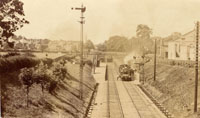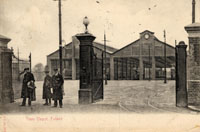Hampton Hill – a 19th c. village
Originally open fields, the population grew rapidly from 1850.

'The history of New Hampton (later Hampton Hill) really commences from the coming in to operation of the Enclosure Act of 1811, when The Common was parcelled out amongst the local property holders, and the various allotments enclosed' wrote Henry Ripley, first historian of Hampton, in 1883. Before enclosure 'The Common' was a place of furze, briers and heather, used by Hamptonians to graze cattle and cut brushwood for fuel. The only known buildings were Upper Lodge in Bushy Park and a windmill, built in 1785.
By 1839 there were a good number of buildings along the High Street, with a few more in Windmill Road and Uxbridge Road, but the rest of the area was still open field. In 1850 there were 24 traders, including three beer retailers. The population grew in the 1850s and 1860s with the arrival of labourers building the Hampton Waterworks and the railway. Many of these people were housed in 'wooden shacks' or 'hovels'. The increase in population led to the building of a new parish church, St James's, in 1863. The first vicar, the Rev F J Fitzwygram, was a man of energy and private means. He set about improving the infrastructure of the village, building cottages and houses and better facilities for the workers, using his own money. The 1861 population of 710 rapidly increased to 1322 in 1871, 2014 in 1881 and to 2440 by 1891.

By the 1880s many new roads had been built and a large area was covered by nurseries. The principal growers were Sherwood's, Page's, Gill's and Milne's Flowers: particularly carnations and daffodils. The face of Hampton Hill changed significantly after the introduction of trams in 1903. Initially much of the line along the High Street was single track with passing loops. From 1904 until 1910 buildings were demolished, in order to accommodate double tracks, and were re-built further back on their sites. The new Fulwell tram terminus was built
Building and infill continued in the 20th century. Sainsbury's supermarket was built on the last nursery, St Clare's, in 1990. The High Street today is still relatively unchanged from a century ago at its southern end but has been considerably re-developed at the northern end in recent years



